Yes. I realised, but asking audiophiles what constitutes proper isolation or best isolation practice, is in broad terms like asking a cross section of the populace what they think is in their best interest.
Herzan/Table Stable "Active" Isolation table.
- Thread starter rockitman
- Start date
You are using an out of date browser. It may not display this or other websites correctly.
You should upgrade or use an alternative browser.
You should upgrade or use an alternative browser.
For best practice: look to what they are doing on the nano scale scientific industries. It is all applicable to High End vinyl replay.
IMHO it is applicable, but you should have a large knowledge and experience with your turntable to know how to apply it. Turntables, rooms and high end systems differ too much to allow a simple scientific approach. I would expect that vintage rim driven turntables having large motors with high torque have different requirements from low power belt driven turntables.
IMHO it is applicable, but you should have a large knowledge and experience with your turntable to know how to apply it. Turntables, rooms and high end systems differ too much to allow a simple scientific approach. I would expect that vintage rim driven turntables having large motors with high torque have different requirements from low power belt driven turntables.
I agree. The other factor that is universally overlooked is the center of gravity.
I agree. The other factor that is universally overlooked is the center of gravity.
the better active devices such as the TS series Herzans include auto leveling as it is required for optimal performance.
the better active devices such as the TS series Herzans include auto leveling as it is required for optimal performance.
Not the same thing. I'd be willing to bet that the Herzian would operate more optimally if the COG of the component was exactly aligned with the dimensional center of the Herzian top plate. The easiest way to tell is to try it. I determine the COG by using a half-round molding and I move the component around until I reach the balance point along right angle axis. I mark this on a tape on the sides and position the turntable as exactly as possible. It is easy to try and easy to hear the difference with isolation platforms.
I do realise that the Herzian due to the active nature of it mechanism is vastly different to passive solutions in practice, but as I said it is easy to find the very close approximate COG and it might be worth experimenting.
Not the same thing. I'd be willing to bet that the Herzian would operate more optimally if the COG of the component was exactly aligned with the dimensional center of the Herzian top plate. The easiest way to tell is to try it. I determine the COG by using a half-round molding and I move the component around until I reach the balance point along right angle axis. I mark this on a tape on the sides and position the turntable as exactly as possible. It is easy to try and easy to hear the difference with isolation platforms.
I do realise that the Herzian due to the active nature of it mechanism is vastly different to passive solutions in practice, but as I said it is easy to find the very close approximate COG and it might be worth experimenting.
I agree.....in theory. and I like your method for finding COG.
my approximately 100 pound direct drive turntable is exactly symmetric in shape; and my 2 tone arms weigh the same, the cartridges are slightly different weight. I center the turntable side to side and front to back within 1/16th of an inch on the top plate of the Herzan. the center of the 50 pound platter is exactly the center of it's three legs/pods.
I'm not claiming that the center of my turntable is perfectly the center of gravity......but functionally it is pretty close. possibly the weight of the tone arms might be slightly to the rear of the turntable. but I doubt whether one could ever hear the difference between the performance of the Herzan as it is now, and if I were to try and adjust for the front to rear weight bias.
OTOH non direct drive turntables are not close to symmetric in shape or weight; most have motors or flywheels that tend to pull the center of gravity to one side to a significant degree. a few are three motor designs that potentially could get more symmetric. I would not be surprised to see a performance difference were someone do the center of gravity calculation and then make adjustments. and it would not surprise me to see some turntables hanging over the side in some of those cases.
and.....likely heavy phono cables might be more culpable in terms of performance compromise to decoupling efforts than center of gravity issues. neutralizing those might be more beneficial.
Last edited:
upon further thinking on this center of gravity issue and active devices; as I recall the Herzan representative 'Whitney Reed' told us at one point that assuming the gear is within the weight spec for the TS unit; center of gravity did not matter. if the platform was level the performance would not be compromised. possibly he may have added that if the gear was so out of balance that the top plate would not level then that would be an issue.
I cannot argue this point, I am simply relating the feedback as I recall it.
and thinking more about it; if stuff needed to be perfectly centered weight wise, why would it need leveling?
I cannot argue this point, I am simply relating the feedback as I recall it.
and thinking more about it; if stuff needed to be perfectly centered weight wise, why would it need leveling?
I agree.....in theory. and I like your method for finding COG.
my approximately 100 pound direct drive turntable is exactly symmetric in shape; and my 2 tone arms weigh the same, the cartridges are slightly different weight. I center the turntable side to side and front to back within 1/16th of an inch on the top plate of the Herzan. the center of the 50 pound platter is exactly the center of it's three legs/pods.
I'm not claiming that the center of my turntable is perfectly the center of gravity......but functionally it is pretty close. possibly the weight of the tone arms might be slightly to the rear of the turntable. but I doubt whether one could ever hear the difference between the performance of the Herzan as it is now, and if I were to try and adjust for the front to rear weight bias.
OTOH non direct drive turntables are not close to symmetric in shape or weight; most have motors or flywheels that tend to pull the center of gravity to one side to a significant degree. a few are three motor designs that potentially could get more symmetric. I would not be surprised to see a performance difference were someone do the center of gravity calculation and then make adjustments. and it would not surprise me to see some turntables hanging over the side in some of those cases.
and.....likely heavy phono cables might be more culpable in terms of performance compromise to decoupling efforts than center of gravity issues. neutralizing those might be more beneficial.
Mike you are spot on about the 'tug' exerted by power cords, phono cables etc.
Re the reservations on using granite, would the same apply to slate?
My TransFi Salvation tt has a 50lb solid slate plinth, and my idea is to run an inert spiked heavy slate single tier support, a Spiers And Robertson air passive (a la Vibraplane) shelf or electronic active (a la Herzan/Accurion) shelf, w possible intervening layer of Symposium Acoustics Quantum Signature platform &/or Shun Mooks Giants Resonators
So, would there likely be some mechanical coupling to go for slate stand under a slate plinthed tt? Certainly my tt has a highly neutral presentation, a big part the designer feels is down to the choice of slate for the plinth
My TransFi Salvation tt has a 50lb solid slate plinth, and my idea is to run an inert spiked heavy slate single tier support, a Spiers And Robertson air passive (a la Vibraplane) shelf or electronic active (a la Herzan/Accurion) shelf, w possible intervening layer of Symposium Acoustics Quantum Signature platform &/or Shun Mooks Giants Resonators
So, would there likely be some mechanical coupling to go for slate stand under a slate plinthed tt? Certainly my tt has a highly neutral presentation, a big part the designer feels is down to the choice of slate for the plinth
About five years ago I investigated the use of the Minus K isolation stand for my self-designed turntable/armpods arrangement
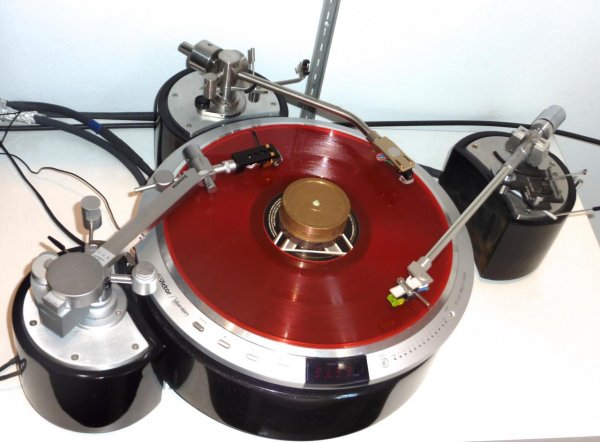
Because of the eccentric loading of the disparate independent parts of my system ......Minus K said....NO!
I first became aware of the Herzan Active TS Series from a Thread I think on Audiogon some time ago but for about a year, I have been reading this comprehensive discussion and it started me thinking again......
Living in Sydney, there was no chance of auditioning a TS-140 before buying so I bit the bullet and wrote to Herzan USA (the Distributor for Australia )
)
Reid Whitney and Tim Rather sorted it all out for me (including a custom 700mmx500mm top-plate) and it arrived via FedEx 3 days after leaving Herzan in California.
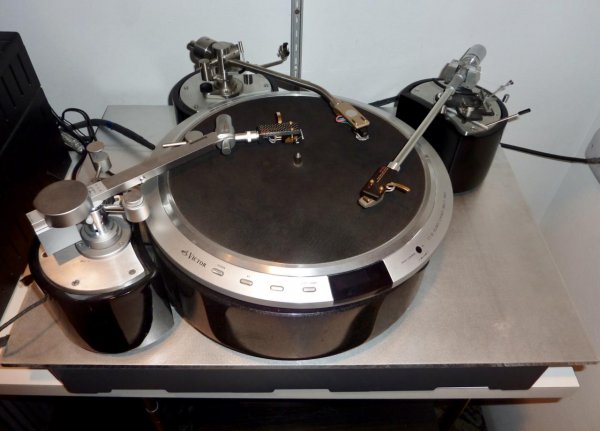
Despite the fact that my floor is a reinforced concrete slab cast on the ground and the turntable was supported on a thick laminated shelf cantilevered from a solid brick wall.....I know that there are low-frequency vibrations in all building structures and materials...particularly materials under stress like suspended floors, shelves and equipment stands.
When materials are in stress (particularly tensile stresses)....they actually emit low-frequency vibrations between 2-10Hz and these frequencies are easily transferred through turntable plinths, motor units, spindles, platters, tonearm mounts and thus into the tonearms, cartridges and vinyl records themselves.
At first there was a slight glitch when a ground-loop hum avoided all attempts at elimination until I cottoned on to the fact that the polished granite cradle and cast-bronze armpods were all supported on stainless steel spikes which rested on the aluminium top-plate. Once dense plastic coasters were inserted under the spikes.....complete silence reined :b
So what are the differences from my previous set-up?
Exactly what I expected.....but still almost unbelievable
The improvements at first seem subtle but are all-encompassing....
Be aware.....this has NO effect on frequency response,
But every frequency SEEMS affected by suddenly having a purity, transparency and 'body' that was somewhat 'cloudy' before the Herzan.
There is absolutely no strain or stress to any music at any volume and as you turn up the volume...so you want to continue turning it up.
I thought perhaps the bass would be deeper or more solid but no.....the bass seems unaffected but all the clarity and delicacy is bestowed upon the midrange and the highs with a singular crystallinity emanating from every cymbal, string, flute and horn.
The first casualties of unwanted vibrations in the analogue domain are the tiniest molecular-sized groove modulations which contain the most ephemeral informational DNA.
Qualities like body, soundstage, spatial depth and positional indications are simply smeared when other unwanted vibrations are present.
The benefits of the Herzan are multiplied four-fold with my turntable arrangement as not only the turntable is affected by the low-frequency vibrations transmitted up from the cantilevered supporting bare shelf.....but every armpod is individually subjected as well.
With most turntables having their tonearm(s) attached to their plinths or armboards......once you effectively isolate the plinth, you don't have to worry so much about the tonearms.
Despite the fact that the Herzan stand cost more than my entire turntable/cradle/armpods and tonearms combined......it is an investment in sound purity which I will never regret

Because of the eccentric loading of the disparate independent parts of my system ......Minus K said....NO!
I first became aware of the Herzan Active TS Series from a Thread I think on Audiogon some time ago but for about a year, I have been reading this comprehensive discussion and it started me thinking again......
Living in Sydney, there was no chance of auditioning a TS-140 before buying so I bit the bullet and wrote to Herzan USA (the Distributor for Australia
Reid Whitney and Tim Rather sorted it all out for me (including a custom 700mmx500mm top-plate) and it arrived via FedEx 3 days after leaving Herzan in California.

Despite the fact that my floor is a reinforced concrete slab cast on the ground and the turntable was supported on a thick laminated shelf cantilevered from a solid brick wall.....I know that there are low-frequency vibrations in all building structures and materials...particularly materials under stress like suspended floors, shelves and equipment stands.
When materials are in stress (particularly tensile stresses)....they actually emit low-frequency vibrations between 2-10Hz and these frequencies are easily transferred through turntable plinths, motor units, spindles, platters, tonearm mounts and thus into the tonearms, cartridges and vinyl records themselves.
At first there was a slight glitch when a ground-loop hum avoided all attempts at elimination until I cottoned on to the fact that the polished granite cradle and cast-bronze armpods were all supported on stainless steel spikes which rested on the aluminium top-plate. Once dense plastic coasters were inserted under the spikes.....complete silence reined :b
So what are the differences from my previous set-up?
Exactly what I expected.....but still almost unbelievable
The improvements at first seem subtle but are all-encompassing....
Be aware.....this has NO effect on frequency response,
But every frequency SEEMS affected by suddenly having a purity, transparency and 'body' that was somewhat 'cloudy' before the Herzan.
There is absolutely no strain or stress to any music at any volume and as you turn up the volume...so you want to continue turning it up.
I thought perhaps the bass would be deeper or more solid but no.....the bass seems unaffected but all the clarity and delicacy is bestowed upon the midrange and the highs with a singular crystallinity emanating from every cymbal, string, flute and horn.
The first casualties of unwanted vibrations in the analogue domain are the tiniest molecular-sized groove modulations which contain the most ephemeral informational DNA.
Qualities like body, soundstage, spatial depth and positional indications are simply smeared when other unwanted vibrations are present.
The benefits of the Herzan are multiplied four-fold with my turntable arrangement as not only the turntable is affected by the low-frequency vibrations transmitted up from the cantilevered supporting bare shelf.....but every armpod is individually subjected as well.
With most turntables having their tonearm(s) attached to their plinths or armboards......once you effectively isolate the plinth, you don't have to worry so much about the tonearms.
Despite the fact that the Herzan stand cost more than my entire turntable/cradle/armpods and tonearms combined......it is an investment in sound purity which I will never regret
Congratulations, Halcro. That looks like a great solution. You write that low frequency vibrations are the result of materials in stress, and the cantilevered shelf must have significant tensile stresses. Would they be less if the turntable were simply placed on a solid conventional rack which would have compressive, rather than tensile, stresses? I also wonder if placing the dense plastic coasters might allow for minute movement between the arm pods and turntable while the spikes might prevent that kind of movement. Pretty clever to have determined the source for that ground loop, but I don't quite understand what created the loop. Could you explain that in more detail?
There were a series of questions asked about the Herzan lights being activated under different conditions, but I can't remember where I saw that, perhaps this very thread. Without the turntable spinning, but with the stylus on an LP, do you see the lights activated on the Herzan? With nothing powered on except the Herzan, do the lights activate? With the turntable on, but arms at rest, do the lights activate? I'm curious about what forces get the lights to activate. Is it just ground borne vibrations, tensile stresses within the cantilevered shelf, or possible air borne vibrations which you could test with say digital music playing (turntable off) generated by the speakers?
BTW, I've always admired the speed accuracy and stability videos that you have posted showing this turntable in operation. It must sound great. I also recall your excellent explanations about the various types of environmental vibrations.
Fascinating stuff. Thanks for posting and sharing your experience. It sounds like a real improvement.
There were a series of questions asked about the Herzan lights being activated under different conditions, but I can't remember where I saw that, perhaps this very thread. Without the turntable spinning, but with the stylus on an LP, do you see the lights activated on the Herzan? With nothing powered on except the Herzan, do the lights activate? With the turntable on, but arms at rest, do the lights activate? I'm curious about what forces get the lights to activate. Is it just ground borne vibrations, tensile stresses within the cantilevered shelf, or possible air borne vibrations which you could test with say digital music playing (turntable off) generated by the speakers?
BTW, I've always admired the speed accuracy and stability videos that you have posted showing this turntable in operation. It must sound great. I also recall your excellent explanations about the various types of environmental vibrations.
Fascinating stuff. Thanks for posting and sharing your experience. It sounds like a real improvement.
About five years ago I investigated the use of the Minus K isolation stand for my self-designed turntable/armpods arrangement
View attachment 31360
Because of the eccentric loading of the disparate independent parts of my system ......Minus K said....NO!
I first became aware of the Herzan Active TS Series from a Thread I think on Audiogon some time ago but for about a year, I have been reading this comprehensive discussion and it started me thinking again......
Living in Sydney, there was no chance of auditioning a TS-140 before buying so I bit the bullet and wrote to Herzan USA (the Distributor for Australia)
Reid Whitney and Tim Rather sorted it all out for me (including a custom 700mmx500mm top-plate) and it arrived via FedEx 3 days after leaving Herzan in California.
View attachment 31361
Despite the fact that my floor is a reinforced concrete slab cast on the ground and the turntable was supported on a thick laminated shelf cantilevered from a solid brick wall.....I know that there are low-frequency vibrations in all building structures and materials...particularly materials under stress like suspended floors, shelves and equipment stands.
When materials are in stress (particularly tensile stresses)....they actually emit low-frequency vibrations between 2-10Hz and these frequencies are easily transferred through turntable plinths, motor units, spindles, platters, tonearm mounts and thus into the tonearms, cartridges and vinyl records themselves.
At first there was a slight glitch when a ground-loop hum avoided all attempts at elimination until I cottoned on to the fact that the polished granite cradle and cast-bronze armpods were all supported on stainless steel spikes which rested on the aluminium top-plate. Once dense plastic coasters were inserted under the spikes.....complete silence reined :b
So what are the differences from my previous set-up?
Exactly what I expected.....but still almost unbelievable
The improvements at first seem subtle but are all-encompassing....
Be aware.....this has NO effect on frequency response,
But every frequency SEEMS affected by suddenly having a purity, transparency and 'body' that was somewhat 'cloudy' before the Herzan.
There is absolutely no strain or stress to any music at any volume and as you turn up the volume...so you want to continue turning it up.
I thought perhaps the bass would be deeper or more solid but no.....the bass seems unaffected but all the clarity and delicacy is bestowed upon the midrange and the highs with a singular crystallinity emanating from every cymbal, string, flute and horn.
The first casualties of unwanted vibrations in the analogue domain are the tiniest molecular-sized groove modulations which contain the most ephemeral informational DNA.
Qualities like body, soundstage, spatial depth and positional indications are simply smeared when other unwanted vibrations are present.
The benefits of the Herzan are multiplied four-fold with my turntable arrangement as not only the turntable is affected by the low-frequency vibrations transmitted up from the cantilevered supporting bare shelf.....but every armpod is individually subjected as well.
With most turntables having their tonearm(s) attached to their plinths or armboards......once you effectively isolate the plinth, you don't have to worry so much about the tonearms.
Despite the fact that the Herzan stand cost more than my entire turntable/cradle/armpods and tonearms combined......it is an investment in sound purity which I will never regret
Congrats Halcro. Good to see another member of the active isolation club.
I agree...it's all about sound purity as you say.
Thank you Christian.Congrats Halcro. Good to see another member of the active isolation club.
I agree...it's all about sound purity as you say.
And thank you for starting this Thread. It was the real inspiration for me actually making the move to the Herzan....
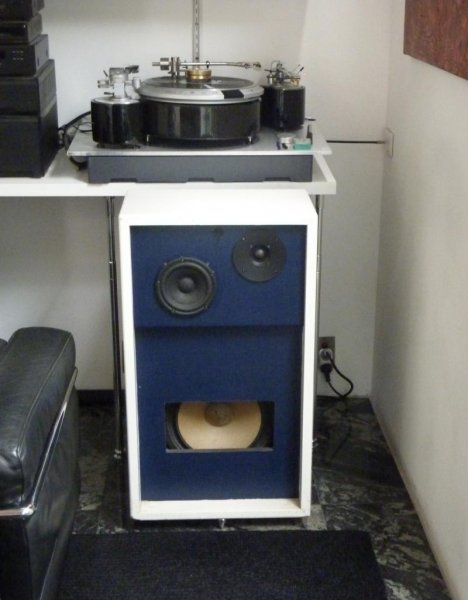
Thanks for the kind words Peter....Congratulations, Halcro. That looks like a great solution. You write that low frequency vibrations are the result of materials in stress, and the cantilevered shelf must have significant tensile stresses. Would they be less if the turntable were simply placed on a solid conventional rack which would have compressive, rather than tensile, stresses? I also wonder if placing the dense plastic coasters might allow for minute movement between the arm pods and turntable while the spikes might prevent that kind of movement. Pretty clever to have determined the source for that ground loop, but I don't quite understand what created the loop. Could you explain that in more detail?
There were a series of questions asked about the Herzan lights being activated under different conditions, but I can't remember where I saw that, perhaps this very thread. Without the turntable spinning, but with the stylus on an LP, do you see the lights activated on the Herzan? With nothing powered on except the Herzan, do the lights activate? With the turntable on, but arms at rest, do the lights activate? I'm curious about what forces get the lights to activate. Is it just ground borne vibrations, tensile stresses within the cantilevered shelf, or possible air borne vibrations which you could test with say digital music playing (turntable off) generated by the speakers?
BTW, I've always admired the speed accuracy and stability videos that you have posted showing this turntable in operation. It must sound great. I also recall your excellent explanations about the various types of environmental vibrations.
Fascinating stuff. Thanks for posting and sharing your experience. It sounds like a real improvement.
I'm glad you enjoyed the videos of the Victor TTs with the Timeline
Not many tables can perform that feat....especially with three arms/cartridges being raised and lowered without any effect on the Timeline.
I've also enjoyed your contributions to not only this Thread, but many of the others that I have read. You have a wonderfully enquiring mind...:b
I can't tell you how many things I tried to define and eliminate the cause of the ground-loop hum. I received no help with any ideas when I posted on A'Gon....
In desperation I called my genius Russian electrician over and he suggested several things which didn't work, however one thing he said, caught my attention......
That evening I thought about getting a wooden top-plate to place over the aluminium and then I thought....before I do that I need to see if the theory works?All that metal sitting on all that other metal makes for funny things....
So the next morning I placed three hard Delrin pads under the granite turntable cradle and the 'hum' reduced significantly. I then put another three under the spikes on one of the armpods and the 'hum' disappeared entirely
I will be getting threaded plastic feet as a more permanent solution.
Yes....a cantilevered shelf will have considerably more stresses in it than a simply supported one and I realised several years ago that the extra weight on my cantilevered shelves were having a detrimental effect on the feedback through BOTH my turntables.
So I added two metal prop-supports under both my turntables...(see photo above)
So my shelves are no longer 'cantilevered' as such.....
Unfortunately, even simply supported shelves are 'bending' and thus subject to tensile stresses. You'll see some manufacturers of audio stands have metal brace supports going at diagonals under the shelves. This is an attempt to reduce the span of the shelves and thus the bending moments and deflections.
The problem with the concept of isolation stands per se.....is that none of them is able to offer any effective barrier to structure-borne feedback below 10Hz and suspended timber floors and even suspended concrete floors, are in a permanent state of tensile stress emitting frequencies as low as 2Hz-5Hz.
Because the Herzan display faces away from my listening position....I don't see it but when I DO look....it is blank.
I might be wrong but I think in reading the instructions, you need to go into the menu to activate the display.....?
The manual explains the menu options on the TS series isolation tables.
http://www.herzan.com/wp-content/uploads/2015/12/Manual-TS-150_-TS-140_-TS-300LP.pdf
http://www.herzan.com/wp-content/uploads/2015/12/Manual-TS-150_-TS-140_-TS-300LP.pdf
Dear Halcro,
Congratulations on your vibration control success and welcome to the club of vibration-free listeners
...and you can easily see some of them (and they also go higher, to 15Hz): Put the needle down on a NON-ROTATING record, connect the pre to a soundcard and run some simple spectrum analyzer/RTA. The better the soundacard low end bandwith, the more vibrations you will see. I could "observe"
the live of my whole house that way before proper decoupling.
What you observe I call "audiospectrum entanglement". The perceprion of sound by our brain is both analytical (e.g. we can detect the frequency of a single tone to a great accuracy) and synthetical-we perceive the sound as a whole, not dividing it into bands. The latter is just engineering/scientific convenience. So what I keep observing healing various systems from vibration is precisely this synthetic effect: Although the decoupling primarly works on sub-sonic to bass frequencies, the effects surprisingly appear in the midrange of even higher (e.g. clear attacks).
What I would suggest as a next step is to decouple the your system. You will hear more of that effect, although not as pronounced as with the source.
I was surprised for example to hear an improvement with SS amplifiers. But the biggest surprise is decoupling of the loudspeakers. This is very much against the common practice of "grounding" but please give it a try if you can! You can actually experiment at a very low cost: just a plywoood and a kid bike tire will give you a hint of the effect Enjoy!
Enjoy!
Congratulations on your vibration control success and welcome to the club of vibration-free listeners
Despite the fact that my floor is a reinforced concrete slab cast on the ground and the turntable was supported on a thick laminated shelf cantilevered from a solid brick wall.....I know that there are low-frequency vibrations in all building structures and materials...particularly materials under stress like suspended floors, shelves and equipment stands.
When materials are in stress (particularly tensile stresses)....they actually emit low-frequency vibrations between 2-10Hz and these frequencies are easily transferred through turntable plinths, motor units, spindles, platters, tonearm mounts and thus into the tonearms, cartridges and vinyl records themselves.
...and you can easily see some of them (and they also go higher, to 15Hz): Put the needle down on a NON-ROTATING record, connect the pre to a soundcard and run some simple spectrum analyzer/RTA. The better the soundacard low end bandwith, the more vibrations you will see. I could "observe"
the live of my whole house that way before proper decoupling.
Be aware.....this has NO effect on frequency response,
But every frequency SEEMS affected by suddenly having a purity, transparency and 'body' that was somewhat 'cloudy' before the Herzan.
There is absolutely no strain or stress to any music at any volume and as you turn up the volume...so you want to continue turning it up.
I thought perhaps the bass would be deeper or more solid but no.....the bass seems unaffected but all the clarity and delicacy is bestowed upon the midrange and the highs with a singular crystallinity emanating from every cymbal, string, flute and horn.
The first casualties of unwanted vibrations in the analogue domain are the tiniest molecular-sized groove modulations which contain the most ephemeral informational DNA.
Qualities like body, soundstage, spatial depth and positional indications are simply smeared when other unwanted vibrations are present.
What you observe I call "audiospectrum entanglement". The perceprion of sound by our brain is both analytical (e.g. we can detect the frequency of a single tone to a great accuracy) and synthetical-we perceive the sound as a whole, not dividing it into bands. The latter is just engineering/scientific convenience. So what I keep observing healing various systems from vibration is precisely this synthetic effect: Although the decoupling primarly works on sub-sonic to bass frequencies, the effects surprisingly appear in the midrange of even higher (e.g. clear attacks).
What I would suggest as a next step is to decouple the your system. You will hear more of that effect, although not as pronounced as with the source.
I was surprised for example to hear an improvement with SS amplifiers. But the biggest surprise is decoupling of the loudspeakers. This is very much against the common practice of "grounding" but please give it a try if you can! You can actually experiment at a very low cost: just a plywoood and a kid bike tire will give you a hint of the effect
Hi Christian,
What have you decided to do about 'powering' the Herzan?
Do you keep it on 24/7?
No. I turn it completely off when I shut down my system (power amps, TT). If I have it on for the day and I plan on listening later, I leave it on...still self-leveling...but I disengage active until I'm ready to listen. No sense putting un-needed wear and tear on the actuators.
The discussion of vibration control devices is somewhat fragmented. In the lab, we use vibration control devices of 3 major types, depending on the needs and objectives of what is necessary for a particular piece of equipment. Electron microscopes, which need to be immune from vertical and horizontal vibrations, generally requires stringent vibration control. Light microscopes or scientific scales typically require less efficient isolation and often more in the horizontal plane than vertical plane.
In all cases, the decisions of what to use are data driven although there are pragmatic considerations as well. Let’s take a look at some specifications. The Herzan TS series indeed provides excellent active vibration control at low frequencies and also some passive control at higher frequencies (>1KHz). If offers vibration attenuation from 0.7 – 1KHz and is 90% effective at 3.5Hz and 99% effective at 10Hz and beyond. That’s impressive. In fact, as Mike noted, they are often used with high mass stands, particularly for sensitive instruments such as electron microscopes as they work best when tightly coupled to the ground.
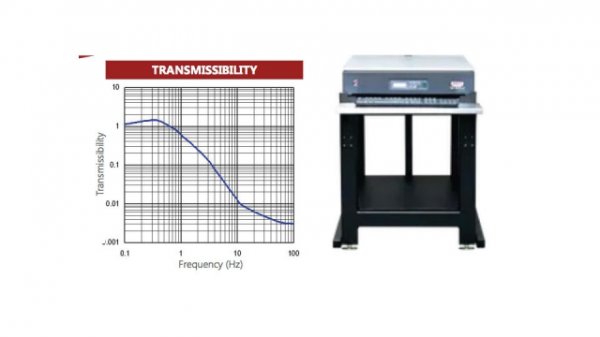
Passive devices generally provide isolation in one or two planes at different efficiencies as shown here.
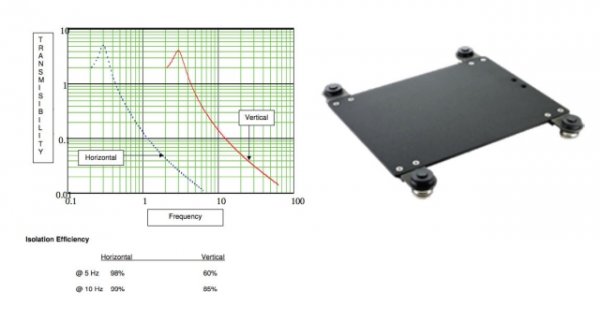
The good news is that they are far cheaper, and the technology is often available as individual footers that can be used with existing platforms or even as foot replacements for individual pieces of gear. There has not been much discussion or use of this tool in this forum as far as I know, although it would seem to be an attractive and inexpensive approach that might work quite well.
http://www.vistekinc.com/images/stories/Designing_with_the_VIB320_8_26.pdf
Lastly, another method of vibration control that has not received much mention are enclosures
No, this isn’t a BBQ, but rather an acoustic enclosure that can be provide meaningful acoustic isolation at higher frequencies.
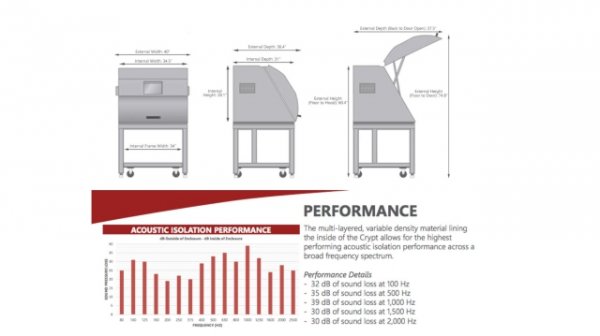
Some have cool names that audiophiles would love such as “The Crypt”, that provide even better access and isolation than the BBQ model. Here too, we can see that acoustic enclosures can be coupled with passive devices inside them
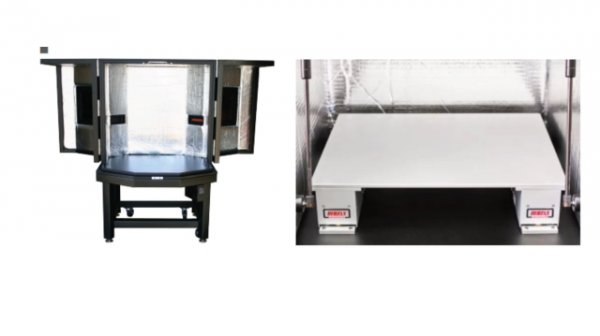
Lastly, as I have mentioned in previous threads, if you are serious about any of these laboratory instruments, you really should check out lab surplus sources where there are plenty of heavy stands, optical benches, active and passive devices available at bargain prices.
http://www.capovani.com/search_results.cfm?subject=1
This source currently has quite a deal on a Herzan device on a massive stand as well as a nice passive platform from Newport
http://www.capovani.com/iinfo.cfm?itemno=162587
http://www.capovani.com/iinfo.cfm?ItemNo=184566
In all cases, the decisions of what to use are data driven although there are pragmatic considerations as well. Let’s take a look at some specifications. The Herzan TS series indeed provides excellent active vibration control at low frequencies and also some passive control at higher frequencies (>1KHz). If offers vibration attenuation from 0.7 – 1KHz and is 90% effective at 3.5Hz and 99% effective at 10Hz and beyond. That’s impressive. In fact, as Mike noted, they are often used with high mass stands, particularly for sensitive instruments such as electron microscopes as they work best when tightly coupled to the ground.

Passive devices generally provide isolation in one or two planes at different efficiencies as shown here.

The good news is that they are far cheaper, and the technology is often available as individual footers that can be used with existing platforms or even as foot replacements for individual pieces of gear. There has not been much discussion or use of this tool in this forum as far as I know, although it would seem to be an attractive and inexpensive approach that might work quite well.
http://www.vistekinc.com/images/stories/Designing_with_the_VIB320_8_26.pdf
Lastly, another method of vibration control that has not received much mention are enclosures
No, this isn’t a BBQ, but rather an acoustic enclosure that can be provide meaningful acoustic isolation at higher frequencies.

Some have cool names that audiophiles would love such as “The Crypt”, that provide even better access and isolation than the BBQ model. Here too, we can see that acoustic enclosures can be coupled with passive devices inside them

Lastly, as I have mentioned in previous threads, if you are serious about any of these laboratory instruments, you really should check out lab surplus sources where there are plenty of heavy stands, optical benches, active and passive devices available at bargain prices.
http://www.capovani.com/search_results.cfm?subject=1
This source currently has quite a deal on a Herzan device on a massive stand as well as a nice passive platform from Newport
http://www.capovani.com/iinfo.cfm?itemno=162587
http://www.capovani.com/iinfo.cfm?ItemNo=184566
Similar threads
- Replies
- 19
- Views
- 1K
- Replies
- 452
- Views
- 95K
- Replies
- 50
- Views
- 20K
- Replies
- 75
- Views
- 20K
- Replies
- 59
- Views
- 24K
| Steve Williams Site Founder | Site Owner | Administrator | Ron Resnick Site Owner | Administrator | Julian (The Fixer) Website Build | Marketing Managersing |

